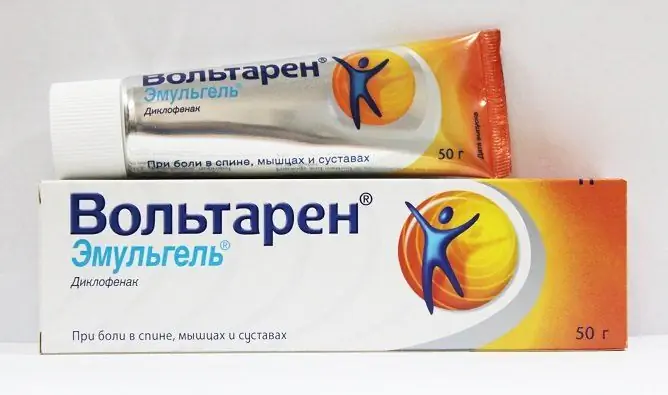- Author Rachel Wainwright [email protected].
- Public 2024-01-15 19:51.
- Last modified 2025-11-02 20:14.
Manual therapy for osteochondrosis of the cervical spine
The content of the article:
- Objectives
- Basic methods of manual therapy
- Methodology
- Mechanism of action of procedures
- Indications
- Contraindications
- Complications
- Video
Manual therapy for osteochondrosis of the cervical spine is one of the components of conservative treatment and includes mostly manual techniques that are aimed at reducing the symptoms of the disease. The effect is on the musculo-ligamentous and musculoskeletal system.
Positive feedback from patients on average in 30-40% of cases (more often a positive effect occurs in milder forms of the disease).

Manual therapy for osteochondrosis can be effective as part of complex treatment
Objectives
- Reducing the manifestations of radicular syndrome, that is, reducing or stopping pain.
- Elimination of reflex spasm of muscles that are strained due to pathological impulses from a compressed nerve root. In fact, this is a natural physiological reaction of the body to create a protective muscle corset around the affected area.
- Elimination of myofascial trigger points. These are areas in which, due to prolonged stress, deformation of proprioceptor nervous regulation occurs. As a result, foci arise, from which incorrect pain signals are sent to the nervous system. A pathological circle is formed: compression of the neurovascular bundle by the affected disc (radicular syndrome) - reflex muscle spasm - time - formation of pathological zones of innervation (triggers) - pathological impulses from the formed triggers in the spinal cord - intensification of manifestations of radicular syndrome.
- Partial restoration of the function of the deformed part of the spinal column (regeneration of the intervertebral disc). The effect on the mobility of the vertebrae arises not due to direct mechanical action, but indirectly due to the enhancement of local blood circulation, restoration of muscle tone and stimulation of metabolic processes in tissues.
- Partial elimination of hemodynamic and trophic disorders (tinnitus, dizziness, headache, impaired sensitivity).
Basic methods of manual therapy
- massage (not classic, but a more gentle version of kneading and stretching muscles);
- post-isometric relaxation;
- post-isotonic relaxation;
- reciprocal relaxation and stretching;
- local pressure of myofascial trigger points;
- rhythmic and positional mobilization (mainly aimed at eliminating joint blockages and is used relatively rarely for the spine).
The specific number of sessions, the method of exposure and the time of the conduct are prescribed by the doctor (chiropractor) after a thorough examination.
Methodology
There are several ways to carry out a set of measures for manual therapy (the sequence of actions is presented in the table).
| Method of exposure | Main focus | Methodology |
| Massage (initial stage) | Increased tone, improved microcirculation. |
Although it is one of the types of manual therapy, it is usually distinguished in a category separate from manual therapy. Impact type: Kneading; Rubbing; · Stretching; Twisting. |
| Mobilization and automobilization (intermediate stage) | Stretching of the ligaments, an increase in the inter-articular gap, an increase in venous and lymphatic outflow. | Soft preparatory effects on the joints. |
| Manipulation (final stage) | Removal of pain syndrome, elimination of muscle spasm, restoration of movements. | It is required to make sharp forced movements in the joints. The patient may hear a crunch in the joints while performing. The rule of thumb is low amplitude and high speed. |
Treatment options:
| Name | Description |
| Applied Kinesiology | Based on the assumption that there is a relationship between muscle structures and internal organs. It is currently considered an alternative therapy and has no convincing clinical trials. It is prescribed in rare cases. |
| Acupuncture (acupuncture) | The technique is associated with a reflex effect on the nerve plexuses using special needles. Knowledge of topographic anatomy (projection of nerve roots onto the skin) is required. It has a number of disadvantages, and the most significant is the individuality of the bedding of the nerve plexuses (it is not always possible, even with proper knowledge, to get into the right zone). |
| Acupressure | Another option for reflexology, but, unlike the previous option, the impact on the acupuncture points occurs with the help of fingers. |
| Myofascial release | A special technique that combines relaxation and stretching of muscle tissue at the same time. |
| Craniosacral therapy | It is associated with the simultaneous effect on the bones of the skull (at the base) and the sacrum. It is more often used for lumbar localization of the disease, with cervical osteochondrosis it is used relatively rarely. |
| Lymphatic drainage massage | Aimed at increasing lymph flow and reducing venous stasis. Eliminates the hemodynamic symptoms of osteochondrosis. It is a good complement to treatment if done correctly. The session lasts on average 30-60 minutes. One course of treatment consists of 5-10 sessions. |
Therapy can last up to 2-3 months with interruptions and include a variety of treatments.
Mechanism of action of procedures
- Mechanical impact on the affected area (manual and hardware methods). Directed effect on the normalization of muscle tone in the neck (collar area)
- The reflex action is associated with an effective effect on the proprioceptors of muscles, ligaments and joint capsules (inhibition of pathological signals at the level of the posterior horns of the spinal cord).

Massage is one of the techniques of manual therapy
Indications
There are a number of indications for manual therapy:
- The defeat of one or more intervertebral discs.
- Stage of formation of intervertebral hernias.
- Functional blockade 2-3 degrees.
- The stage of remission or compensation. In the acute phase, the method causes additional pain.
It can be used for polysegmental lesions of the spinal column (cervical and thoracic regions or cervical and lumbar regions).
Contraindications
- Malignant neoplasms in the terminal stage. This contraindication is especially important in osteosarcomas.
- Infectious and inflammatory diseases of various origins in the acute stage.
- Diseases of the musculoskeletal system with severe deformation, inflammation or dystrophic processes. The most typical diseases of this group: polyarthritis, arthrosis, intervertebral hernias in the sequestration stage.
- Fresh traumatic injuries of the spine.
- Anomalies of the development of the spinal column.
- Arterial hypertension in the stage of decompensation.
- Pregnancy and early postpartum period.
- Early postoperative period.
The above list can be supplemented depending on the individual clinical picture of cervical osteochondrosis (predominance of a particular syndrome, stage of the disease).
Complications
Any effect on the body can have complications; with manual therapy, the chance of their occurrence is 5-7%. Approximate liver complications:
- Fractures of ribs, vertebrae, or other structures. It occurs extremely rarely (no more than 0.1%).
- Displacement of articular surfaces under significant mechanical pressure. It often occurs when trying to reposition the vertebrae relative to the articular surfaces in violation of the technique and rules of manual therapy (therefore, only muscle tissue stretching is allowed without attempts to reposition bone structures).
- Infringement of an intervertebral hernia. It occurs in the case of an incorrect diagnosis (the stage of the hernia is important) and the appointment of a course of manual therapy for hernia sequestration.
- It is shown to be performed only under the supervision of a specialist to avoid even a minimal risk of complications.
Video
We offer for viewing a video on the topic of the article.

Anna Kozlova Medical journalist About the author
Education: Rostov State Medical University, specialty "General Medicine".
Found a mistake in the text? Select it and press Ctrl + Enter.






